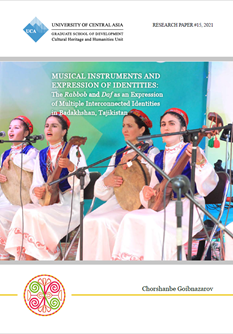Musical Instruments and Expression of Identities: The Rabbob and Daf as an Expression of Multiple Interconnected Identities in Badakhshan, Tajikistan
This article focuses on the Pamiri rabbob, a plucked lute utilized by Ismaili Muslims living in the remote Pamir Mountains of southeastern Tajikistan, which helps to understand the expression of various identities. The identities are interconnected and are expressed through the music, the instruments, and the craftsmanship with which the instruments are manufactured. Added to this are the anecdotes and memories associated with the instruments, which give further meaning and context to the local musical expression. The meaning and value of music and musical instruments are defined by the interaction between the social and cultural situations in which they occur, and the inherent qualities attributed to them by the musicians and their audiences. My analysis focuses on cases in which musical instruments bring out religious, cultural, and national identities and help shore up an identitarian defense against dominant political and cultural forces. As any scholars have shown (Dawe, 2003; Baily, 1976; Doubleday, 1999; Rancier, 2014, Bates, 2012), musical instruments are significant sources for studying culture and society. Apart from being attractive for their unique sounds, shapes, and auras, musical instruments symbolize the traditions and identities of peoples, nations, sub-national regions, and ethnic groups. They have specific cultural meanings and these meanings emerge from local histories and traditions. They are not only commodities but are meaningful by virtue of the cultural values they assume at a given moment in history.



